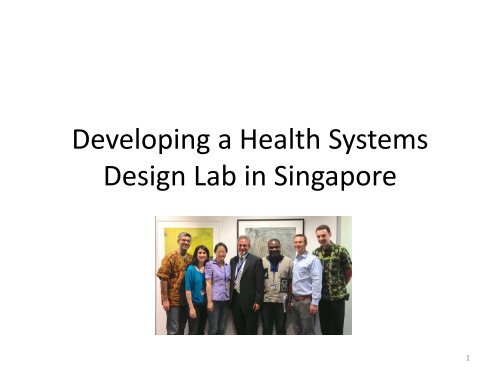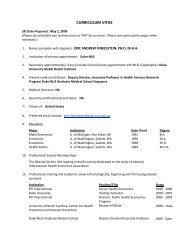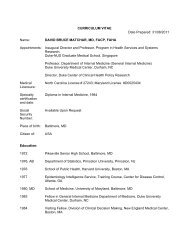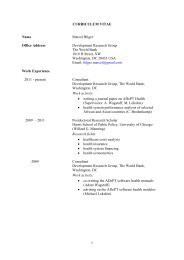Developing a Health Systems Design Lab in Singapore
Developing a Health Systems Design Lab in Singapore
Developing a Health Systems Design Lab in Singapore
You also want an ePaper? Increase the reach of your titles
YUMPU automatically turns print PDFs into web optimized ePapers that Google loves.
<strong>Develop<strong>in</strong>g</strong> a <strong>Health</strong> <strong>Systems</strong><br />
<strong>Design</strong> <strong>Lab</strong> <strong>in</strong> S<strong>in</strong>gapore<br />
1
Team Members<br />
• John Ansah, Research Fellow<br />
• Angelique Chan, Associate Professor<br />
• Choy Lye Chei, Research Fellow<br />
• Young Do, Assistant Professor<br />
• Robert Eberle<strong>in</strong>, Consultant<br />
• Am<strong>in</strong>a Islam, Project Manager<br />
• Carmen Lee, Research Assistant<br />
• Sean Love, Research Assistant<br />
2
Team Members<br />
• Rahul Malhotra, Assistant Professor<br />
• David Matchar, Pr<strong>in</strong>cipal Investigator<br />
• Truls Ostybe, Professor<br />
• Nicholas Perk<strong>in</strong>s, Research Associate<br />
• Crystal Riley, Research Assistant<br />
• Yasuhiko Saito, Consultant<br />
• Monika Setia, Research Fellow<br />
• Yuan Tian, Research Associate<br />
• James Thompson, Senior Associate <strong>in</strong> Research<br />
3
Goals<br />
• Establish a capability <strong>in</strong> a systems model<strong>in</strong>g<br />
(particularly System Dynamics (SD) model<strong>in</strong>g)<br />
• Apply SD to key problems <strong>in</strong> health care to a<br />
population with a rapidly chang<strong>in</strong>g<br />
demographic (focus<strong>in</strong>g <strong>in</strong>itially on dementia)<br />
• Develop capacity <strong>in</strong> S<strong>in</strong>gapore to create and<br />
make effective use of model<strong>in</strong>g<br />
4
Apply SD to key problems <strong>in</strong> an ag<strong>in</strong>g<br />
population<br />
• Develop a deep understand<strong>in</strong>g<br />
– Focused <strong>in</strong>terviews of stakeholders <strong>in</strong> dementia<br />
care<br />
• Insights<br />
– The general problems are not entirely unique to S<strong>in</strong>gapore<br />
– A fundamental concern is how to meet the needs of<br />
<strong>in</strong>dividuals with dependency and chronic conditions<br />
– Data rema<strong>in</strong>s sparse<br />
5
Foundational efforts<br />
• Model the dynamics of the S<strong>in</strong>gapore<br />
population<br />
– Ag<strong>in</strong>g<br />
– Family size<br />
– Dependency (<strong>in</strong>clud<strong>in</strong>g dementia)<br />
6
The S<strong>in</strong>gapore Population Model<br />
BIRTH RATE<br />
<br />
BIRTH RATE<br />
MULTIPLIER<br />
measured birth<br />
rate<br />
FRACTION<br />
FEMALE<br />
fecund female<br />
cohort<br />
<br />
population shift<br />
<br />
AGE SPECIFIC<br />
DEATH RATE<br />
IMMIGRATION OF AGE<br />
GROUP WEIGHT<br />
total immigration of<br />
age group weight<br />
births<br />
Resident<br />
Population<br />
deaths<br />
fraction immigration<br />
of age group<br />
TRANSPOSED<br />
AGE GROUP<br />
fraction immigrat<strong>in</strong>g<br />
by age<br />
<br />
total immigrat<strong>in</strong>g<br />
<br />
immigration by<br />
age<br />
emigrat<strong>in</strong>g<br />
AGE COHORT<br />
EMIGRATION RATE<br />
deaths grouped<br />
SWITCH OFF<br />
EMIGRATION<br />
resident<br />
population 60 and<br />
over<br />
resident population<br />
grouped<br />
<br />
AGE GROUP<br />
family size by age<br />
average family size for<br />
elderly 60 years and<br />
older<br />
AGE OF ELDERLY<br />
birth year<br />
average children<br />
by age<br />
<br />
<br />
AVERAGE<br />
TOTAL FERTILITY<br />
7
Identify an urgent problem related to<br />
service needs, and a policy partner<br />
• The significant problem: long-term care<br />
options for dependent elders<br />
• The policy partner: The Agency for Integrated<br />
Care<br />
– Coord<strong>in</strong>ates the transition from hospital to<br />
community<br />
– Engages <strong>in</strong> plann<strong>in</strong>g and advocacy for service<br />
development<br />
– Collects data on needs, utilization, outcomes<br />
8
The Long-term Care Model<br />
9
An iterative process<br />
Simulation<br />
Conceptual<br />
model<br />
Consultation<br />
Insights<br />
New data<br />
collection<br />
10
Build<strong>in</strong>g capacity<br />
• Workshops<br />
– Initially 1-3 day sessions to develop <strong>in</strong>terest and<br />
understand<strong>in</strong>g <strong>in</strong> systems model<strong>in</strong>g and its<br />
potential<br />
– This year: team project-based<br />
• Problem formulation<br />
• Tutorials <strong>in</strong> model<strong>in</strong>g basics<br />
• Hands-on sessions to translate to application<br />
• 3 month follow on to achieve “closure”<br />
11
Ongo<strong>in</strong>g work<br />
• Exam<strong>in</strong>ation of the dynamic relationship<br />
between capacity <strong>in</strong> different sectors of the<br />
system (acute hospital, community hospital,<br />
cl<strong>in</strong>ics, and private services)<br />
• Focus on us<strong>in</strong>g models as a framework for<br />
identify<strong>in</strong>g and evaluat<strong>in</strong>g promis<strong>in</strong>g strategies<br />
for meet<strong>in</strong>g needs <strong>in</strong> a way that is susta<strong>in</strong>able<br />
• Work<strong>in</strong>g with colleagues to develop a<br />
community of researchers and stakeholders<br />
12







